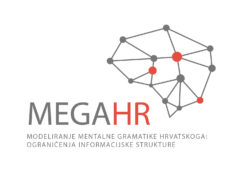AGIĆ, Željko and Nikola LJUBEŠIĆ (2015). “Universal Dependencies for Croatian (that Work for Serbian, too).” Proceedings of the 5th Workshop on Balto-Slavic Natural Language Processing. Hissar, Bulgaria. 1-8.
AJDUKOVIĆ, Marina and KOLESARIĆ (ur.) (2003). Etički kodeks istraživanja s djecom. Zagreb: Vijeće za djecu Vlade Republike Hrvatske. Državni zavod za zaštitu obitelji, materinstva i mladeži.
BATES, Elizabeth and Judith C. GOODMAN (1997). “On the Inseparability of Grammar and the Lexicon: Evidence from Acquisition, Aphasia and Real-time Processing.” Language and Cognitive Processes, 12:5-6: 507-584.
BOCK, Kathryn J. (1999). “Co-ordinating Words and and Syntax in Speech Plans.” u: Progress in the Psychology of Language, ur. Andrew W. Ellis; 337-388.
CHOMSKY, Noam (1957). Syntactic Structures. The Hague: Mouton & Co.
DABROWSKA, Ewa (2012) “Different speakers, different grammars: Individual differences in native language attainment”. Linguistic Approaches to Bilingualism 2: 219-253 (keynote article with peer commentary).
GOLDBERG, Adele (1995). Constructions. Chicago: University of Chicago Press.
GOLDBERG, Adele (2006). Constructions at Work: the nature of generalization in language. Oxford University Press, Oxford.
HASPELMATH, Martin (2014). «The geometry of grammatical meaning: Semantic maps and cross-linguistic comparison.» In: (Ed.) Michael Tomasello, The New Psychology of language Structure: Cognitive and Functional Approaches to Language Structure. Psychology Press and Routledge Classic Editions. 211-242.
HASPELMATH, Martin (2007). “Pre-established categories don’t exist: Consequences for language description and typology.» Linguistic Typology, Vol 11, Issue 1: 119-132.
HOPPER, Paul (1987). “Emergent grammar.” Berkeley Linguistics Society 13: 139-157.
HILPERT, Martin (2008). “New evidence against the modularity of grammar: Constructions, collocations, and speech perception.” Cognitive Linguistics 19–3: 483–503.
JACKENDOFF, Ray (1983). Semantics and Cognition. Cambridge, MA: MIT Press.
JACKENDOFF, Ray (1987). Consciousness and the Computational Mind. Cambridge, MA: MIT Press.
JACKENDOFF, Ray (1990). Semantic Structures. Cambridge, MA: MIT Press.
JACKENDOFF, Ray (1997). The Architecture of the Language Faculty. Cambridge, MA: MIT Press.
JACKENDOFF, Ray (2002). Foundations of Language: Brain, Meaning, Grammar, Evolution. Oxford: Oxford University Press.
JACKENDOFF, Ray (2012). A User’s Guide to Thought and Meaning. Oxford: Oxford University Press. (hrvatsko izdanje Vodič kroz mišljenje i značenje, 2016. IHJJ)
KLUBIČKA, Filip and Nikola LJUBEŠIĆ (2014). “Using crowdsourcing in building a morphosyntactically annotated and lemmatized silver standard corpus of Croatian.” Language technologies: Proceedings of the 17th International Multiconference Information Society IS2014. Ljubljana. 1-8.
LAMBRECHT, Knud (1994). Information structure and sentence form: Topic, focus and the mental representation of discourse referents. Cambridge: Cambridge University Press.
LANGACKER, Ronald (1987). Foundations of Cognitive Grammar. Stanford: Stanford University Press.
LEVELT, Willem et al. (1999). “A theory of lexical access in speech production.” Behavioral and Brain Sciences, 22: 1-75.
MACDONALD, Maryellen C., Neal J. PEARLMUTTER and Mark S. SEIDENBERG (1994). “Lexical Nature of Syntactic Ambiguity Resolution.” Psychological Review 101:4; 676-703.
FERREIRA, Victor S. i Gary S. DELL (2000). “Effect of Ambiguity and Lexical Availability on Syntactic and Lexical Production.” Cognitive Psychology 40: 296-340.
PETI-STANTIĆ, Anita (2005). “Sposobnost između lingvistike i komunikacije.” Semantika prirodnog jezika i metajezik semantike : zbornik Hrvatskoga društva za primijenjenu lingvistiku / Granić, Jagoda (ur.). Zagreb-Split; 599-606
PETI-STANTIĆ, Anita (2014). “Informacijska struktura rečenice i fonološko-sintaktičko sučelje.” Rasprave Instituta za hrvatski jezik i jezikoslovlje vol 39. Zagreb. 557-580.
PETI-STANTIĆ, Anita (2014a). “Informativity of the sentence information structure: word order.” Language as Information. (ur.) Anita Peti-Stantić, Mateusz Milan Stanojević. Peter Lang Verlag. 155-178.
PETI-STANTIĆ, Anita (2015). “How much Grammar is needed in Lexicon?” Slovnica in slovar: aktualni jezikovni opis/Grammar and Dictionary: Current language description, (ur.) Smolej, Mojca, Ljubljana: Center za slovenščino kot drugi/tuji jezik, Filozofska fakulteta v Ljubljani: 569-577
PICKERING, Martin J. and Victor S. FERREIRA (2008). “Structural Priming: A Critical Review.” Psychological Bulletin 134:3; 427-459.
PUSTEJOVSKY, James (1991). “The Generative Lexicon.” Computational Linguistics 17:4; 409-441.
SCHÖNEFELD, Doris (2001). Where lexicon and syntax meet. Trends in Linguistics. Studies and Monographs 135. Mouton de Gruyter.
STANOJEVIĆ, Mateusz-Milan (2011). “Modeling epistemic distance: the Croatian l-participle.” Suvremena lingvistika 37: 72; 219-239.
VRANIĆ, Andrea and Mirjana TONKOVIĆ (2011). “Što ispitujemo testovima pamćenja?: Odnosa metamemorije i objektivnih mjera pamćenja” Suvremena psihologija (1331-9264) 14:2; 201-211.
2,767 total views, 1 views today
This post is also available in:  Hrvatski (Croatian)
Hrvatski (Croatian)

